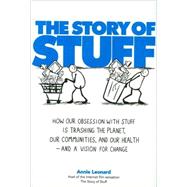We have a problem with Stuff. With just 5 percent of the world’s population, we’re consuming 30 percent of the world’s resources and creating 30 percent of the world’s waste. If everyone consumed at U.S. rates, we would need three to five planets!
This alarming fact drove Annie Leonard to create the Internet film sensation The Story of Stuff, which has been viewed over 10 million times by people around the world. In her sweeping, groundbreaking book of the same name, Leonard tracks the life of the Stuff we use every day—where our cotton T-shirts, laptop computers, and aluminum cans come from, how they are produced, distributed, and consumed, and where they go when we throw them out. Like Rachel Carson’s Silent Spring, The Story of Stuff is a landmark book that will change the way people think—and the way they live.
Leonard’s message is startlingly clear: we have too much Stuff, and too much of it is toxic. Outlining the five stages of our consumption-driven economy—from extraction through production, distribution, consumption, and disposal—she vividly illuminates its frightening repercussions. Visiting garbage dumps and factories around the world, Leonard reveals the true story behind our possessions—why it’s cheaper to replace a broken TV than to fix it; how the promotion of "perceived obsolescence" encourages us to toss out everything from shoes to cell phones while they’re still in perfect shape; and how factory workers in Haiti, mine workers in Congo, and everyone who lives and works within this system pay for our cheap goods with their health, safety, and quality of life. Meanwhile we, as consumers, are compromising our health and well-being, whether it’s through neurotoxins in our pillows or lead leaching into our kids’ food from their lunchboxes—and all this Stuff isn’t even making us happier! We work hard so we can buy Stuff that we quickly throw out, and then
We want new Stuff so we work harder and have no time to enjoy all our Stuff. . . . With staggering revelations about the economy, the environment, and cultures around the world, alongside stories from her own life and work, Leonard demonstrates that the drive for a "growth at all costs" economy fuels a cycle of production, consumption, and disposal that is killing us.
It is a system in crisis, but Annie Leonard shows us that this is not the way things have to be. It’s within our power to stop the environmental damage, social injustice, and health hazards caused by polluting production and excessive consumption, and Leonard shows us how. Expansive, galvanizing, and sobering yet optimistic, The Story of Stuff transforms how we think about our lives and our relationship to the planet.








